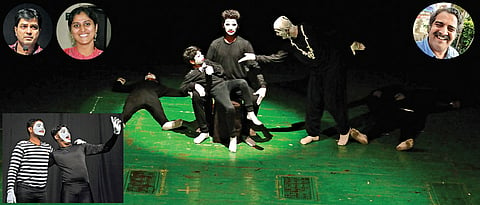

Theatre is about expressions; words declaimed powerfully can take the play to a new high, but expressing your feelings without resorting to speech is a challenge for the actors. And, if done correctly, it takes theatre to new heights.
One such competition that allows you to explore yourself and your surroundings without the aid of words is Maunaantar 2017 — a mime play competition.
Organised by Dreams 2 Reality, Wide Wings Media and Fairytale Media Studio, Maunaantar 2017 will be held from June 30 to July 2 at Bharat Natya Mandir.
A relatively new competition, Maunaantar 2017 is in its fourth edition now. We chat up with the judges of the previous editions to find out what they expect this year and what the participants should bear in mind.
Excerpts:
PICK SOMETHING FROM LITERATURE
Girish Pardeshi, actor
I judged the competition last year and was curious to find out what was in store. To my surprise, most of the participants were quite enthusiastic and energetic. There were some flaws in terms of following the rules, but as performances or works of art, they were brilliant.
The group that won the first prize, had chosen a simple topic about answering nature’s call. But they elaborated and expanded on it so wonderfully. The teams which didn’t win, also came up with wonderful themes. I remember one group had chosen a Charlie Chaplin theme and the other group had picked up tribal lore as the subject. There were also many styles of performances like using dance format, which I think was great. Maunaantar is restrictive in some ways, but it also gives you a chance to enhance your creativity in more ways.
This year I hope the participants will touch upon some social subjects. I am also looking forward to works of literature being culminated in their performances. They could pick a story from Hindi or Marathi literature or even Shakespeare. They could improvise on a poem by William Wordsworth, or maybe delve into haiku format.
COMMUNICATE THROUGH YOUR BODY
Devika Daftardar, actor
I judged the competition consecutively for two years. For an actor, the medium of expression is his/her body. So it’s a big challenge for every actor to communicate only through his body’s motions, without expressing his thoughts vocally. And, that’s wherein lies Maunaantar’s significance. Having said that not many are fully aware of what miming means. Miming doesn’t mean not speaking, but communicating through your body. So I think orientation workshops are necessary for the participants.
Another point that I would like to stress upon is that when you act without taking help of speech and dialogues, you realise the importance of other factors like lights, set properties and use of physical space. In the competition that I judged, the participating teams didn’t make good use of lights. You can’t afford to ignore lights, costumes and properties.
I also felt that there was a dearth of good literature. The participants worked on their germ of ideas, and they acted brilliantly. But I felt that it would be great if the teams chose to dig into our literature — short stories, novellas etc. It would enrich the competition.
POSSIBILITIES ARE IMMENSE
Pradeep Vaiddya, theatre veteran
I was the judge for the first two years. This concept is new and we realised that grooming was necessary. Some groups played out their act in such a way that one would feel the tone/volume lessened or drowned out. That’s not miming.
Mime is considered as an art form in Europe. The basic format is that the actors wear a white mask and neutral clothes. But there are various forms too — like Charlie Chaplin’s pantomime, clowning. Then, Mr Bean’s slapstick comedy is also another advanced form of mime. There are many possibilities within mime. In India, we have muk natya or silent play format, which also has immense possibilities like dance drama, realistic plays etc.
The challenge that Maunaantar poses before the participants is to convey their stories through actions, and not bow down before words. So how you write a story is not so much important as much as how you tell it. One good example is Atul Pethe’s performance in Nished, a short film.
ST READER SERVICE
The registration forms of the competition are available till June 8.
You can download them from www.d2rpune.com/Maunantar.aspx
Follow the writer on Twitter @riceandpickle
